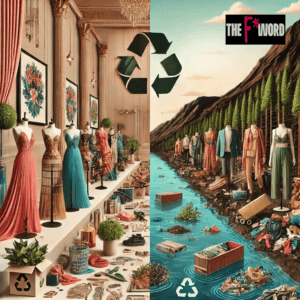Fashion is ever-changing, but one trend needs to stay: sustainability!
With the fashion industry being one of the most environmentally damaging sectors, it’s time to act and make more eco-friendly choices. Here’s your guide on how to be sustainable in fashion.
Why Sustainability in Fashion Matters
The fashion industry contributes heavily to pollution, water waste, and carbon emissions. Every year, millions of tons of clothing end up in landfills. Fast fashion accelerates these problems, promoting disposable clothing habits. By choosing sustainable options, you can help reduce this environmental impact.
Practical Steps for a Sustainable Wardrobe
Being sustainable doesn’t mean sacrificing style. Here’s how you can make eco-friendly fashion choices:
1. Invest in Quality Over Quantity
Focus on buying fewer, better-quality pieces that last longer. This reduces waste and saves money.
- Timeless Pieces: Invest in classic styles that don’t go out of fashion.
- Durability: Choose well-made items that withstand wear.
A good quality item may cost more but pays off in longevity.
2. Choose Sustainable Fabrics
The material of your clothes matters. Some fabrics have a high environmental cost, while others are more eco-friendly.
Examples of Sustainable Fabrics:
- Organic Cotton: Grown without harmful chemicals and uses less water.
- Bamboo: A renewable resource that grows quickly with minimal pesticides.
- Tencel and Lyocell: Made from wood pulp in a closed-loop process, reducing waste and emissions.
- Recycled Fabrics: Materials like recycled polyester and nylon use existing resources, reducing energy consumption.
Always check clothing labels for these materials and avoid synthetic fabrics like conventional polyester, which are petroleum-based and non-biodegradable.
3. Embrace Slow Fashion
Slow fashion emphasizes quality and ethical production over mass manufacturing.
- Buy From Ethical Brands: Support companies that pay fair wages and ensure good working conditions.
- Shop Local: Reduce the carbon footprint by buying locally produced clothing.
- Support Small Businesses: Many independent designers focus on sustainability.
Slow fashion is about thoughtful, purposeful buying that reduces harm.
How to Shop Sustainably
Changing shopping habits makes a huge difference.
1. Thrift, Swap, or Rent Clothes
Shopping second-hand or renting special occasion outfits keeps clothing in use longer and reduces waste.
- Thrift Shopping: Vintage and second-hand stores offer unique finds.
- Clothing Swaps: Exchange items with friends or go to swap events.
- Renting Services: Platforms like Rent the Runway let you borrow designer clothes for events, saving money and reducing consumption.
Embracing pre-loved fashion keeps clothing in circulation, lowering environmental impact.
2. Upcycle and Customize
Get creative and breathe new life into old clothes. Upcycling gives your wardrobe a unique, personalized touch.
- DIY Projects: Turn old jeans into shorts or repurpose worn-out T-shirts.
- Tailoring: Adjust clothes that no longer fit to extend their lifespan.
Upcycling also reduces the demand for new production, cutting down on resource use.
3. Practice Mindful Washing
How you care for your clothes matters. Washing less often and at lower temperatures reduces water and energy use.
- Cold Wash: Use cold water and eco-friendly detergents.
- Line Dry: Air drying saves energy and preserves fabric.
- Avoid Dry Cleaning: choose eco-friendly dry cleaners.
These small changes can make your clothes last longer while conserving resources.
Understanding Fast Fashion’s Impact
Fast fashion brands release new collections often, encouraging overconsumption. This business model drives enormous waste, poor labor conditions, and environmental destruction.
- Water Usage: Textile production uses vast amounts of water. For example, producing one cotton shirt requires 2,700 liters.
- Pollution: Factories release toxic chemicals into rivers, harming ecosystems and communities.
- Carbon Emissions: Transporting clothing worldwide contributes significantly to global greenhouse gases.
Choosing not to support fast fashion means rejecting these harmful practices and focusing on ethics and sustainability.
The Benefits of Supporting Ethical Fashion
Ethical fashion brands focus on sustainability, fair labor, and transparency. Supporting them has real-world benefits.
- Workers’ Rights: Ethical brands ensure fair wages and safe working conditions.
- Eco-Friendly Processes: Many use low-impact dyes, reduce water usage, and embrace closed-loop systems.
- Transparency: You know where and how your clothes are made, giving you peace of mind.
How to Be an Informed Consumer
Before buying, research brands to ensure they align with your values.
- Check Certifications: Look for certifications like GOTS (Global Organic Textile Standard) and Fair Trade.
- Read Reviews: Honest reviews can reveal if a brand’s claims hold up.
- Learn About Company Practices: Visit brand websites and read their sustainability reports.
Your purchasing power can push the industry towards more sustainable practices.
The Future of Sustainable Fashion
Innovation is driving the future of fashion. Technologies like 3D printing, biodegradable materials, and circular fashion models are setting new standards.
- 3D Printing: Allows for made-to-order clothing, reducing fabric waste.
- Circular Fashion: Promotes reuse and recycling, aiming for zero waste.
- Biodegradable Clothing: New materials, like mushroom leather and algae-based fabrics, break down without harming the environment.
Conclusion
Knowing how to be sustainable in fashion empowers you to make a positive impact. Small actions, like choosing ethical brands, investing in quality pieces, and caring for your clothes, add up.
As more people embrace eco-friendly practices, the fashion industry will shift towards sustainability, protecting our planet for future generations.
Browse more articles on “Sustainability in Fashion“





